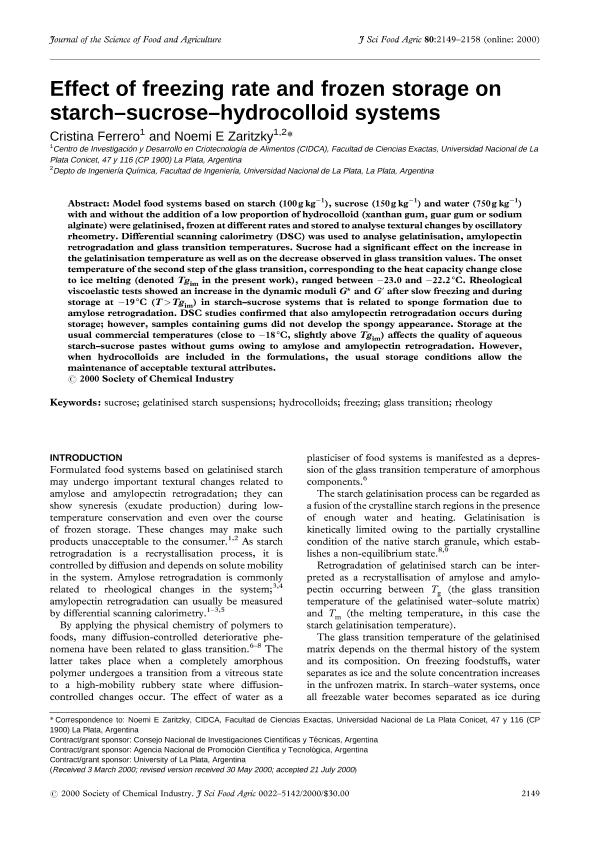Artículo
Effect of freezing rate and frozen storage on starch-sucrose-hydrocolloid systems
Fecha de publicación:
11/2000
Editorial:
John Wiley & Sons Ltd
Revista:
Journal of the Science of Food and Agriculture
ISSN:
0022-5142
e-ISSN:
1097-0010
Idioma:
Inglés
Tipo de recurso:
Artículo publicado
Clasificación temática:
Resumen
Model food systems based on starch (100g kg-1), sucrose (150g kg-1) and water (750g kg-1)with and without the addition of a low proportion of hydrocolloid (xanthan gum, guar gum or sodium alginate) were gelatinised, frozen at different rates and stored to analyse textural changes by oscillatory rheometry. Differential scanning calorimetry (DSC) was used to analyse gelatinisation, amylopectin retrogradation and glass transition temperatures. Sucrose had a significant effect on the increase in the gelatinisation temperature as well as on the decrease observed in glass transition values. The onset temperature of the second step of the glass transition, corresponding to the heat capacity change close to ice melting (denoted Tgim in the present work), ranged between -23.0 and -22.2 °C. Rheological viscoelastic tests showed an increase in the dynamic moduli G* and G´ after slow freezing and during storage at -19°C (T>Tgim) in starch-sucrose systems that is related to sponge formation due to amylose retrogradation. DSC studies conÆrmed that also amylopectin retrogradation occurs during storage; however, samples containing gums did not develop the spongy appearance. Storage at the usual commercial temperatures (close to -18°C, slightly above Tgim) affects the quality of aqueous starch±sucrose pastes without gums owing to amylose and amylopectin retrogradation. However, when hydrocolloids are included in the formulations, the usual storage conditions allow the maintenance of acceptable textural attributes.
Archivos asociados
Licencia
Identificadores
Colecciones
Articulos(CIDCA)
Articulos de CENTRO DE INV EN CRIOTECNOLOGIA DE ALIMENTOS (I)
Articulos de CENTRO DE INV EN CRIOTECNOLOGIA DE ALIMENTOS (I)
Citación
Ferrero, Cristina; Zaritzky, Noemi Elisabet; Effect of freezing rate and frozen storage on starch-sucrose-hydrocolloid systems; John Wiley & Sons Ltd; Journal of the Science of Food and Agriculture; 80; 14; 11-2000; 2149-2158
Compartir
Altmétricas




